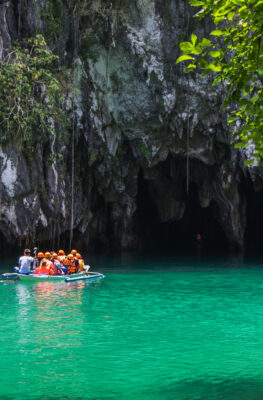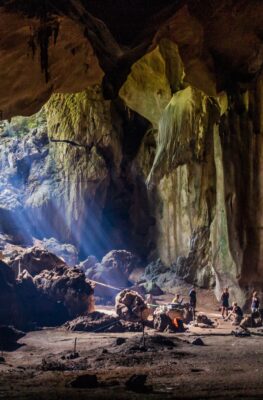Published on January 15, 2010

My first climbs were a means to an end…jumping into a waterfall pool in central New York’s Finger Lakes region. Tourists know this glacier-gouged region for its vineyards and Cornell University, but local kids sneak down farm paths to free climb 20-40 meter walls with plenty of holds and deep water as a net.
In 1992, I landed a job on Krabi’s Railay Beach.Thailand’s limestone karsts slingshot me back to my childhood. While equipped climbers tackled a Phranang Headland wall, my friend Ron and I anchored his boat and free climbed a pocked cliff in Ao Nang Bay. But again, water was my net.
Today, climbing has spread throughout Thailand. Northeast Korat province presents Poo Tam Par Daar Dabaat, a 40 meter limestone crag with nine easy routes to a Buddha cave. A dozen walls around Chiang Mai include “Crazy Horse’s” 16 crags with 14 multi-pitch routes (5.6-5.13). A bit north of Bangkok, Lopburi Province’s Jeen Lair Mountain boasts 40 bolted routes.
Some climbers say Vietnam’s Halong Bay, with its hundreds of karst islands, is the next Railay. A boat ride from Cat Ba leads to Monkey Island and loads of free-climbing options. However, sinking bolts in the rocks of this UNESCO World Heritage site may halt further climbing development.
Cambodia’s climbing scene presents a crag with giant boulder-like formations northeast of Phnom Penh in Kampong Province. The climb requires a 60 meter rope, some slings and carabineers, though glued anchors top most routes. Leaders need a half dozen draws, and locals can be hired to machete through the vegetation and carry your gear.
Big walls rise high in Sabah, and Sarawak’s jungle boasts granite faces, but peninsular Malaysia offers some great established routes, especially at Batu Caves just north of Kuala Lumpur, where limestone crags fade into granite cliffs. “Comic Wall” features some 12 short, but tough bolted routes, and nearby “Roadshow” challenges climbers with steep overhangs.
“Mosquito” inBahasa offers more than 50 steep, long routes (5a – 8a+ on the French grading system) with boulder blocks and some frightening landing zones. “White Wall” presents 16, 30-meter technical routes on a smooth, slightly overhanging wall with stainless steel anchors.
In Indonesia, Java’s basalt, granite, sandstone, and limestone walls deliver bouldering and big wall climbs. Siung Beach near Yogyakarta has over 40 routes (5.9 – 5.13), with “Pacaran” and “9 Bor” among the favorites. Seropan features fun cave climbs, though many claim “Bon Appetite” (5.13c) is the toughest route in central Java, and “King of Kings” (5.12a) is absolutely vertical.
Pecatu on Bali features five routes with plenty of bouldering and sharp holds, but is best approached at low tide. Songan’s tough “Coklat” (5.10a) has seven bolts and no place to rest, “Canangsari’s” (5.11c) 7 bolts and single piton head up a crack and over the small roof, and the fun but frightening “Mbok Siki” (5.10c) with only two bolts is quite high off the deck.
The Philippines is riddled with routes for beginners or veteran climbers. In Quezon, south of Manila near Lucena, an abandoned limestone quarry presents 25 established routes (5.5 – 5.13), some as high as 70 meters. The north wall has yet to be tackled, and is begging for a first ascent. In Mindanao near Iligan, the Baranggay Puga-an limestone crag presents four bolted routes.
Indoor climbing gyms dot cosmopolitan Singapore, but in Bukit Timah, granite walls at the “Dairy Farm” quarry presents a climber’s haven with some decent routes, but wear a helmet as rock falls are common.
In Laos, a local ecotourism operator offers climbing programs up Vang Vieng’s limestone walls about four hours north of Vientiane. An equal distance south of the capital, the Nam Kading National Protected Area boasts a massive 1,500 meter vertical limestone wall.
Though off limits, I coaxed a village headman to lead me along a three-hour trail to the cave-filled face for an easy 50 meter free climb. I could have gone further, but without equipment or water for a net, discretion took hold. Still, the wall has great potential and took me straight back to my days as a kid sneaking down a path in upstate New York.
Vientiane-based Bernie Rosenbloom writes for TTG Asia, PATA Compass, and EcotourismLaos.com; and he co-authored The Responsible Tourism Guide to Cambodia, Laos and Vietnam.






